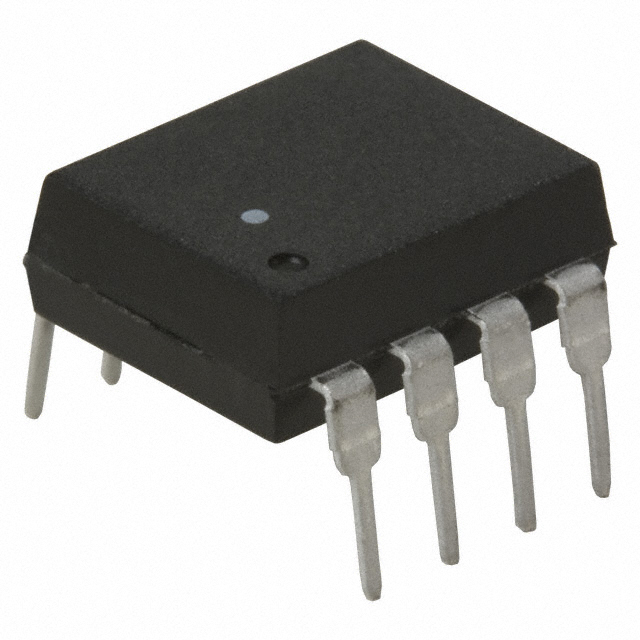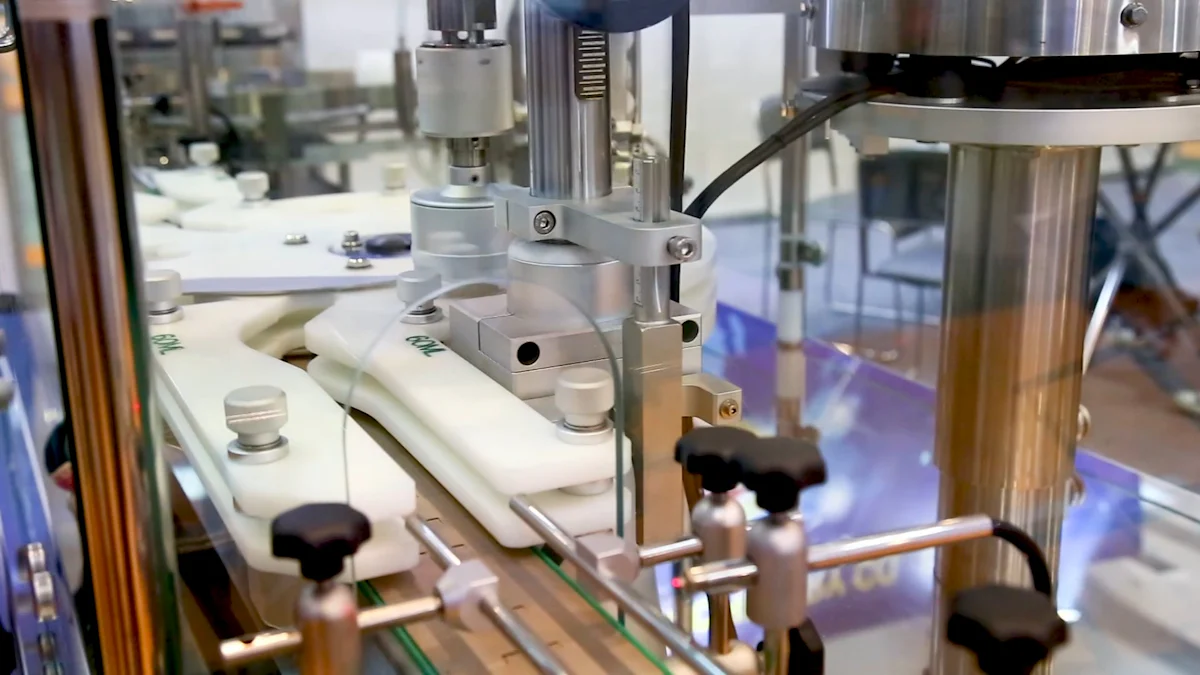Exploring Avago's HCNR201-000E for Industrial Control

The HCNR201-000E, produced by Avago, is a high-linearity analog optocoupler that excels in industrial control environments by providing dependable isolation for analog signals. This analog isolator ensures both stability and linearity, making it an excellent choice for applications that demand high-voltage isolation. By effectively separating analog inputs from digital circuits, the HCNR201-000E enhances both safety and performance. Its adaptability allows it to function in various modes, addressing a wide range of analog isolation challenges. For more detailed specifications, visit here.
Understanding the HCNR201-000E
What is the HCNR201-000E?
The HCNR201-000E, developed by AVAGO, serves as a high-linearity analog optocoupler. It plays a crucial role in isolating analog signals across various applications. This device features a high-performance AlGaAs LED that illuminates two closely matched photodiodes. The input photodiode monitors and stabilizes the LED's light output, effectively eliminating non-linearity and drift characteristics. The output photodiode generates a photocurrent directly proportional to the LED's light output. This design ensures high linearity and stable gain, making it suitable for industrial, medical, and telecommunications applications requiring high-voltage isolation.
Key Features and Specifications
Electrical Characteristics
The HCNR201-000E boasts impressive electrical characteristics. It provides excellent stability and linearity, essential for precise signal transmission. The device operates efficiently in both AC and DC modes, offering flexibility in various applications. Its low non-linearity makes it ideal for scenarios demanding high accuracy in signal processing. Additionally, the optocoupler supports unipolar and bipolar operations, enhancing its versatility.
Physical Dimensions
The HCNR201-000E comes in an 8-pin PDIP-W package, facilitating easy integration into electronic circuits. Its compact design allows for seamless incorporation into space-constrained environments. The physical dimensions ensure compatibility with a wide range of industrial control systems, making it a preferred choice for engineers and designers.
Importance in Industrial Control
In industrial control settings, the HCNR201-000E functions as a reliable analog isolator. It separates analog inputs from digital circuits, enhancing safety and performance. By providing dependable isolation, it prevents interference and ensures accurate signal transmission. This optocoupler addresses various analog isolation challenges, making it indispensable in modern industrial applications. Its adaptability allows it to function in multiple modes, catering to diverse industrial needs. For more detailed specifications, visit here.
Components of the HCNR201-000E
Internal Structure
The internal structure of the HCNR201-000E, an analog optocoupler developed by Avago, plays a crucial role in its functionality as an analog isolator. This structure ensures precise signal transmission and effective isolation in various industrial applications.
Light Emitting Diode (LED)
At the heart of the HCNR201-000E lies a high-performance AlGaAs LED. This LED emits light that serves as the primary medium for signal transmission. The emitted light is stable and consistent, which is essential for maintaining linearity and reducing signal distortion. The LED's design ensures minimal drift, making it reliable for long-term use in industrial settings.
Photodetector
The photodetector component of the HCNR201-000E consists of two closely matched photodiodes. These photodiodes play a pivotal role in converting the light signal back into an electrical signal. The input photodiode monitors the LED's light output, ensuring stability and eliminating non-linearity. The output photodiode generates a photocurrent proportional to the light received, allowing for accurate signal reproduction. This configuration enhances the device's performance as an analog isolator.
External Connections and Pin Configuration
The HCNR201-000E features an 8-pin PDIP-W package, which facilitates easy integration into various electronic circuits. The pin configuration is designed to simplify connections and ensure compatibility with a wide range of industrial control systems. Each pin serves a specific function, contributing to the overall efficiency and effectiveness of the device.
Pin 1 and Pin 2: These pins connect to the LED, allowing for the input of the analog signal.
Pin 3 and Pin 4: These are typically used for grounding and stabilizing the circuit.
Pin 5 and Pin 6: These pins connect to the output photodiode, enabling the transmission of the converted electrical signal.
Pin 7 and Pin 8: These are often used for additional grounding or auxiliary functions, depending on the specific application.
The practical chip design of the HCNR201-000E ensures that it meets the demands of modern industrial applications. Its components work in harmony to provide reliable analog isolation, making it a preferred choice for engineers and designers. For more detailed specifications。
How the HCNR201-000E Functions
Signal Transmission Process
The HCNR201-000E, an analog optocoupler developed by Avago, plays a pivotal role in signal isolation. It achieves this through a well-defined signal transmission process that ensures high linearity and stability.
Light Signal Conversion
The signal transmission begins with the conversion of an electrical signal into a light signal. The high-performance AlGaAs LED within the HCNR201-000E emits light proportional to the input signal. This light serves as the medium for transmitting the signal across the isolation barrier. The LED's design minimizes drift and distortion, ensuring that the light signal remains stable and consistent. This stability is crucial for maintaining the integrity of the transmitted signal.
Electrical Isolation Mechanism
Once the light signal crosses the isolation barrier, the photodetector component of the HCNR201-000E converts it back into an electrical signal. This conversion process involves two closely matched photodiodes. The input photodiode monitors the LED's light output, ensuring stability and eliminating non-linearity. The output photodiode generates a photocurrent proportional to the light received, allowing for accurate signal reproduction. This mechanism provides galvanic isolation, effectively separating the input and output signals. Such isolation is essential in preventing interference and ensuring accurate signal transmission in industrial applications.
Advantages of Using Optocouplers
Optocouplers, like the HCNR201-000E, offer several advantages in industrial control settings. They provide reliable isolation for analog signals, enhancing both safety and performance. By separating analog inputs from digital circuits, optocouplers prevent interference and ensure accurate signal transmission. This capability is particularly valuable in applications that demand high-voltage isolation.
Moreover, optocouplers are cost-effective solutions for analog isolation. They offer excellent stability, linearity, and bandwidth, making them suitable for a wide range of applications. Their adaptability allows them to function in various modes, addressing diverse isolation challenges. In industrial settings, optocouplers contribute to noise reduction and enhance safety and protection, making them indispensable components in modern control systems.
Applications in Industrial Control

Common Use Cases
Motor Control Systems
Motor control systems benefit significantly from the HCNR201-000E. This optocoupler provides reliable isolation for analog signals, ensuring precise control of motor speed and torque. Engineers use it to separate high-voltage components from low-voltage control circuits, enhancing safety and performance. The HCNR201-000E's high linearity and stability make it ideal for applications requiring accurate signal transmission. By preventing interference, it ensures smooth and efficient motor operation, which is crucial in industrial environments.
Data Acquisition Systems
Data acquisition systems rely on the HCNR201-000E for accurate signal isolation. This optocoupler separates analog inputs from digital processing units, ensuring data integrity. Its ability to maintain high linearity and stability makes it suitable for applications that demand precise measurements. Engineers use the HCNR201-000E to prevent noise and interference, which can distort data. By providing dependable isolation, it enhances the accuracy and reliability of data acquisition systems in industrial settings.
Benefits in Industrial Settings
Noise Reduction
The HCNR201-000E plays a vital role in reducing noise in industrial control systems. By isolating analog signals, it prevents interference from external sources. This capability ensures that signals remain clear and undistorted, which is essential for accurate control and monitoring. The optocoupler's design minimizes drift and distortion, further enhancing signal quality. In noisy industrial environments, the HCNR201-000E contributes to improved system performance and reliability.
Safety and Protection
Safety and protection are paramount in industrial control settings. The HCNR201-000E enhances safety by providing galvanic isolation between high-voltage and low-voltage components. This isolation prevents electrical faults from affecting sensitive control circuits, reducing the risk of damage and accidents. Engineers rely on the HCNR201-000E to ensure that control systems operate safely and efficiently. Its robust design and reliable performance make it an indispensable component in modern industrial applications.
Comparing HCNR201-000E with Other Optocouplers
Performance Metrics
The HCNR201-000E stands out in the realm of analog optocouplers due to its exceptional performance metrics. It features a high-performance AlGaAs LED, which illuminates two closely matched photodiodes. This design ensures high linearity and stable gain characteristics, making it superior to many other analog optocouplers. The input photodiode stabilizes the LED's light output, virtually eliminating non-linearity and drift. This capability is crucial for applications requiring precise signal transmission.
In contrast, common analog optocouplers often consist of a light-tight package housing a light source and a single photoconductive cell. These devices typically control the output resistance by varying the input current or voltage. While they can switch between on/off states or track input signals in an analog manner, they may not offer the same level of linearity and stability as the HCNR201-000E.
Moreover, the HCNR201-000E's fast 100ns response time makes it ideal for high-frequency applications. This quick response is particularly beneficial in industrial settings where rapid signal processing is essential. Other high linearity optocouplers may not match this speed, limiting their use in such demanding environments.
Cost-Effectiveness
When evaluating cost-effectiveness, the HCNR201-000E proves to be a valuable investment for industrial control systems. Its advanced design and high-performance components ensure reliable operation, reducing the need for frequent replacements or maintenance. This durability translates into long-term cost savings for engineers and designers.
While some analog optocouplers may have a lower initial cost, they often lack the stability and linearity provided by the HCNR201-000E. These shortcomings can lead to increased expenses over time due to potential signal inaccuracies and system inefficiencies. By investing in the HCNR201-000E, users benefit from a device that delivers consistent performance and minimizes operational disruptions.
Future Developments and Projects
Emerging Trends in Optocoupler Technology
Optocoupler technology continues to evolve, driven by the demand for improved performance and efficiency in industrial applications. One emerging trend is the integration of optocouplers with advanced semiconductor materials. These materials enhance the speed and reliability of signal transmission, making optocouplers more effective in high-frequency applications.
Another trend involves the miniaturization of optocouplers. As electronic devices become more compact, the need for smaller components grows. Manufacturers are developing optocouplers with reduced physical dimensions without compromising their performance. This trend aligns with the increasing demand for space-efficient solutions in modern industrial systems.
Additionally, the development of optocouplers with enhanced isolation capabilities is gaining traction. Engineers seek devices that provide superior galvanic isolation to prevent interference and ensure accurate signal transmission. This advancement is particularly relevant in applications like motor drivers and power monitors, where precise control and monitoring are crucial.
Potential Innovations with HCNR201-000E
The HCNR201-000E, a high-linearity analog optocoupler, holds significant potential for future innovations. Its versatility makes it suitable for various industrial applications, including voltage and current sensing, as well as current loops. Designers can quickly implement the HCNR201-000E in their projects using evaluation boards, facilitating rapid prototyping and testing.
One area of potential innovation lies in enhancing the HCNR201-000E's performance metrics. By incorporating advanced materials and design techniques, manufacturers can further improve its linearity and stability. This enhancement would make the HCNR201-000E even more attractive for applications demanding high accuracy in signal processing.
Moreover, the HCNR201-000E could play a pivotal role in the development of smart industrial systems. As industries move towards automation and digitalization, the need for reliable signal isolation becomes paramount. The HCNR201-000E's ability to provide dependable isolation makes it an ideal candidate for integration into smart control systems, contributing to the advancement of Industry 4.0 initiatives.
The HCNR201-000E stands out as a vital component in industrial control systems. Its ability to provide reliable analog signal isolation enhances both safety and performance. Key benefits include noise reduction and precise signal transmission, making it indispensable in motor control and data acquisition systems. Looking ahead, advancements in optocoupler technology promise further enhancements in speed and miniaturization. The HCNR201-000E's potential for integration into smart industrial systems positions it as a crucial player in the evolution of Industry 4.0.
See Also
Exploring C8051F340-GQR's Role in Automation Solutions
Insights into FA5511N-D1-TE1 for Power Management
Assessing ULN2803ADWR for Various Industrial Uses

